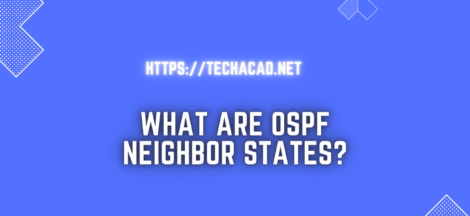OSPF is a link-state routing protocol that creates and keeps neighbor relationships by sharing routing updates with other OSPF routers. No routing information is exchanged and the only packets they exchange are Hello packets. Hello packets enables dynamic neighbor discovery and preserve neighbor connections. Passive interface command is used to suppress OSPF hello packets on a specified interface. It is also used in other routing protocols like RIP and EIGRP.
Enabling passive interfaces in our network devices mean that:
- OSPF continues to announce or advertise the interface’s connected network.
- OSPF routers stop sending OSPF Hellos on the interface.
- On the interface, OSPF no longer processes any received Hellos.
In OSPF (Open Shortest Path First), a passive interface is an interface on which OSPF routing updates are not transmitted or received. This means that the router will not send or receive OSPF hello packets on a passive interface, and it will not form neighbor relationships with other OSPF routers on that interface.
There are a few reasons why you might want to configure a passive interface:
- To reduce the amount of OSPF traffic on the network: By not sending or receiving OSPF hello packets on a passive interface, you can reduce the amount of OSPF traffic on the network. This is especially useful if the interface is connected to a network segment that does not require OSPF routing.
- To prevent the router from forming neighbor relationships on the interface: In some cases, you may want to prevent the router from forming neighbor relationships with other OSPF routers on a particular interface. Configuring the interface as passive will accomplish this.
- To prevent the router from advertising routes on the interface: If you do not want the router to advertise any routes on a particular interface, you can configure the interface as passive. This will prevent the router from sending any routing updates on the interface.
To configure a passive interface in OSPF, you can use the “passive-interface” command in router configuration mode. For example:
Router#conf t
Router(config)#router ospf 1
Router(config-router)#passive-interface fa0/0This will configure interface Fa0/0 as a passive interface in OSPF process 1.
If we need all interfaces to be passive interfaces and leaving a single or a couple of interfaces non-passive, we can set passive interface as the default configuration by using the ‘passive-interface default’ command:
Router#conf t
Router(config)#router ospf 1
Router(config-router)#passive-interface default
Router(config-router)#no passive-interface fa0/0Verify OSPF Passive Interface Status with show command
To verify that a particular interface is configured as a passive interface in OSPF, you can use the “show ip ospf interface” command. This command will display the OSPF status of all interfaces on the router.
For example, if you want to verify that interface Fa0/0 is a passive interface in OSPF process 1, you can use the following command:
show ip ospf interface fa0/0This will display the OSPF status of interface Fa0/0. If the interface is a passive interface, it will show “Passive” in the “State” field.
Here is an example of the output you might see:
Router# show ip ospf interface fa0/0
FastEthernet0/0 is up, line protocol is up
Internet Address 10.1.1.1/24, Area 0
Process ID 1, Router ID 10.1.1.1, Network Type BROADCAST, Cost: 1
Transmit Delay is 1 sec, State PASSIVE, Priority 1
Designated Router (ID) 10.1.1.2, Interface address 10.1.1.1
No backup designated router on this network
Timer intervals configured, Hello 10, Dead 40, Wait 40, Retransmit 5
No Hellos (Passive interface)
Index 1/1, flood queue length 0
Next 0x0(0)/0x0(0)
Last flood scan length is 1, maximum is 1
Last flood scan time is 0 msec, maximum is 0 msec
Neighbor Count is 0, Adjacent neighbor count is 0
Suppress hello for 0 neighbor(s)Take note that this interface is no longer sending OSPF Hellos or processing any received Hellos in our OSPF domain. In this lesson we discussed OSPF passive interfaces and developed understanding on how to configure OSPF passive interfaces in Cisco IOS.

